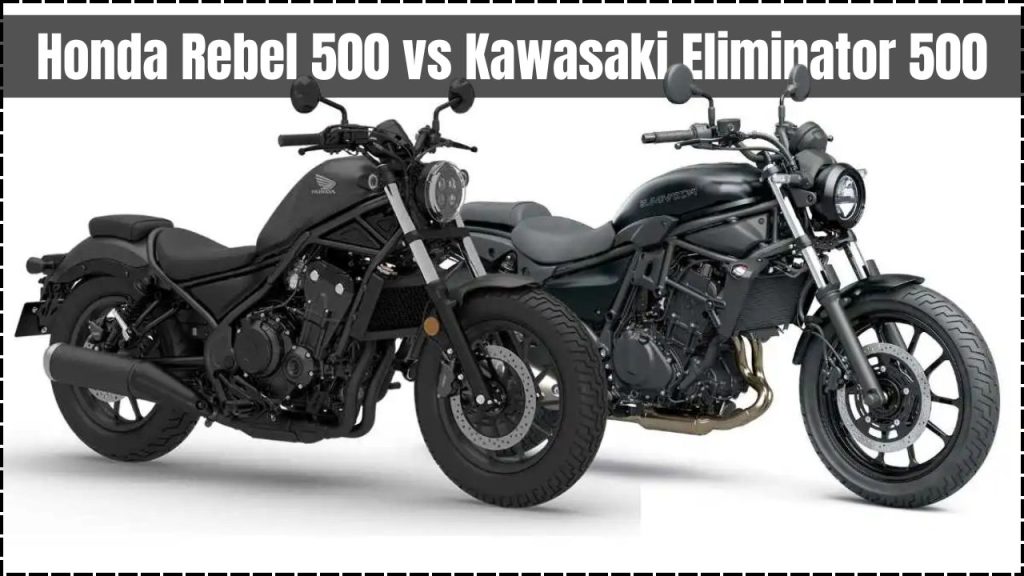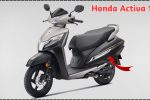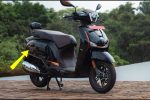
Honda has finally brought the Rebel 500 to Indian shores, and cruiser enthusiasts couldn’t be more excited. Priced at Rs 5.12 lakh ex-showroom, the Honda Rebel enters a competitive segment where it faces the Kawasaki Eliminator 500 head-on. Both bikes are Japanese cruisers, which is interesting since we usually think of cruisers as American territory or Royal Enfield’s domain.
Design and Styling
The Honda Rebel 500 takes a minimalist approach with its bobber-inspired design. It features a low-slung profile, a compact peanut-shaped fuel tank, and plenty of blacked-out components. The bike screams simplicity and elegance with its clean lines and understated appeal. Available only in Matt Gunpowder Black Metallic, the Rebel looks like it means business without trying too hard.
The Kawasaki Eliminator 500, on the other hand, goes for a more traditional cruiser look. It has a muscular fuel tank, conventional cruiser proportions, and styling that gives it serious road presence. The Eliminator comes in Metallic Flat Black and definitely looks more imposing than the Honda. If you want people to notice you riding past, the Kawasaki might be your pick.
Both bikes look great, but they appeal to different tastes. The Rebel is for those who like understated cool, while the Eliminator is for riders who want that classic cruiser vibe.
Engine Performance
Here’s where things get interesting. Both bikes use liquid-cooled parallel-twin engines, but there are some key differences worth noting.
| Engine Specs | Honda Rebel 500 | Kawasaki Eliminator 500 |
|---|---|---|
| Displacement | 471cc | 451cc |
| Power | 45.5 bhp @ 8,500 rpm | 44.7 bhp |
| Torque | 43.3 Nm @ 6,000 rpm | 42.6 Nm |
| Transmission | 6-speed | 6-speed |
The Honda has a slightly bigger engine and produces marginally more power and torque. The Rebel’s engine is designed for smooth, tractable power delivery that works great in city traffic and relaxed highway cruising. It’s the kind of engine that doesn’t surprise you with sudden power surges.
The Kawasaki’s engine comes from the Ninja 400 family, so it has a sportier character. While it makes slightly less power on paper, the Eliminator is 15kg lighter than the Rebel, which could make it feel more responsive in real-world riding.
Neither bike gets a quickshifter, which is understandable at this price point. Both engines are refined and should offer good fuel efficiency for their respective sizes.
Build Quality and Equipment
This is where both bikes are remarkably similar. They share almost identical hardware, which speaks to the maturity of this segment.
| Equipment | Honda Rebel 500 | Kawasaki Eliminator 500 |
|---|---|---|
| Front Suspension | Telescopic forks | Telescopic forks |
| Rear Suspension | Dual shocks | Dual shocks |
| Front Tire | 130/90-16 | 130/70-18 |
| Rear Tire | 150/80-16 | 150/80-16 |
| Front Brake | 296mm single disc | 310mm single disc |
| Rear Brake | 240mm single disc | 240mm single disc |
| ABS | Dual-channel | Dual-channel |
| Weight | 191 kg | 176 kg |
The Kawasaki has a slight edge with its bigger front brake disc and 18-inch front wheel (compared to the Rebel’s 16-inch), which should provide better braking and more traditional cruiser handling. The 15kg weight advantage is also significant and could make the Eliminator feel more nimble.
Both bikes get dual-channel ABS, alloy wheels, and LED lighting, so you’re covered on the safety and modern features front.
Dimensions and Comfort
This is where the two bikes differ and where your personal preferences will matter most.
| Dimensions | Honda Rebel 500 | Kawasaki Eliminator 500 |
|---|---|---|
| Length | 2,190 mm | 2,250 mm |
| Width | 820 mm | 785 mm |
| Height | 1,093 mm | 1,100 mm |
| Seat Height | 690 mm | 735 mm |
| Ground Clearance | 136 mm | 150 mm |
| Fuel Tank | 11.2 liters | 13 liters |
The Honda Rebel’s biggest selling point is its incredibly low 690mm seat height. This makes it accessible to shorter riders and beginners who might feel intimidated by taller bikes. You can easily put both feet flat on the ground, which gives confidence when maneuvering in traffic or parking.
The Kawasaki sits 45mm higher, but at 735mm, it’s still quite accessible for most riders. What the Eliminator gives you in return is better ground clearance (150mm vs 136mm) and a larger fuel tank. If you plan to do touring or ride on rougher roads, these advantages matter.
Features and Technology
Modern motorcycles need modern features, and both bikes deliver the basics well.
| Features | Honda Rebel 500 | Kawasaki Eliminator 500 |
|---|---|---|
| Display | Negative LCD | LCD cluster |
| Lighting | Full LED | Full LED |
| Connectivity | No | Yes (SE variant) |
| USB Charging | No | Yes (SE variant) |
| Cameras | No | Yes (SE variant) |
The Honda keeps things simple with a negative LCD display that shows all the essential information clearly. It’s easy to read and fits the bike’s minimalist philosophy.
The Kawasaki goes a step further, especially in the SE variant, which gets smartphone connectivity and even front and rear cameras. These features make the Eliminator feel more modern, though they also add to the cost.
Pricing and Value
Here’s where the Honda shines.
| Pricing | Honda Rebel 500 | Kawasaki Eliminator 500 |
|---|---|---|
| Ex-showroom Price | Rs 5.12 lakh | Rs 5.76 lakh |
| Difference | – | Rs 64,000 more |
| Availability | 3 cities | Pan-India |
The Honda Rebel 500 costs Rs 64,000 less than the Kawasaki Eliminator 500. That’s not pocket change. For many buyers, this price difference could be the deciding factor.
However, there’s a catch. The Rebel is currently available only in Gurugram, Mumbai, and Bengaluru through Honda BigWing dealerships. The Kawasaki is available across India through regular Kawasaki dealers.
Real-World Riding
The Honda Rebel 500 is designed for easy, relaxed riding. The low seat height and approachable power delivery make it perfect for city commuting and weekend rides. It’s the kind of bike that doesn’t intimidate new riders but still offers enough performance to keep experienced riders happy.
The Kawasaki Eliminator 500 feels more like a traditional cruiser. The higher seating position, better ground clearance, and larger fuel tank make it better suited for longer rides and varied road conditions. It’s still beginner-friendly, but it has more touring potential than the Honda.
Neither bike is built for aggressive riding or track days. They’re both about relaxed cruising, comfortable ergonomics, and looking good while doing it.
Maintenance and Service
Honda has a massive service network in India, which is a huge advantage for long-term ownership. Parts availability and service costs are generally reasonable for Honda motorcycles.
Kawasaki has a smaller but specialized network. Service quality is usually good, but you might have to travel further to reach a dealership in some areas.
Which One Should You Buy?
The choice depends on what you prioritize:
Choose the Honda Rebel 500 if:
- You’re a shorter rider or beginner
- Budget is important to you
- You primarily ride in the city
- You like minimalist design
- You want Honda’s reliability and service network
Choose the Kawasaki Eliminator 500 if:
- You plan to do more touring
- You prefer traditional cruiser looks
- Technology features matter to you
- You need better ground clearance
- You’re willing to pay extra for additional capabilities
The Verdict
Both bikes are excellent choices in the mid-capacity cruiser segment. The Honda Rebel 500 wins on price, accessibility, and simplicity. It’s the perfect entry point into cruiser motorcycles and offers great value for money.
The Kawasaki Eliminator 500 offers a more complete cruiser experience with better touring capabilities and traditional styling. It costs more, but you get additional features and capabilities for that premium.
In the end, both motorcycles represent the best of Japanese engineering and reliability. They’re both significant improvements over what was available in this segment just a few years ago. The choice comes down to your personal needs, budget, and riding style.
For most first-time cruiser buyers, the Honda Rebel 500’s combination of low price, easy handling, and Honda reliability makes it hard to beat. But if you want a more traditional cruiser experience and don’t mind paying extra for it, the Kawasaki Eliminator 500 won’t disappoint either.

Katherine Johnson is a passionate writer with a keen interest in storytelling, content creation, and creative expression. She enjoys exploring diverse topics and crafting engaging narratives that captivate readers.



